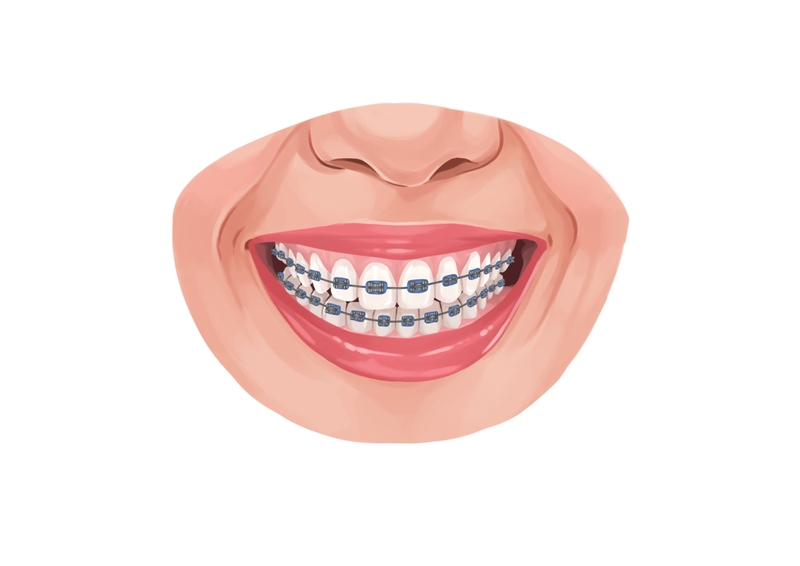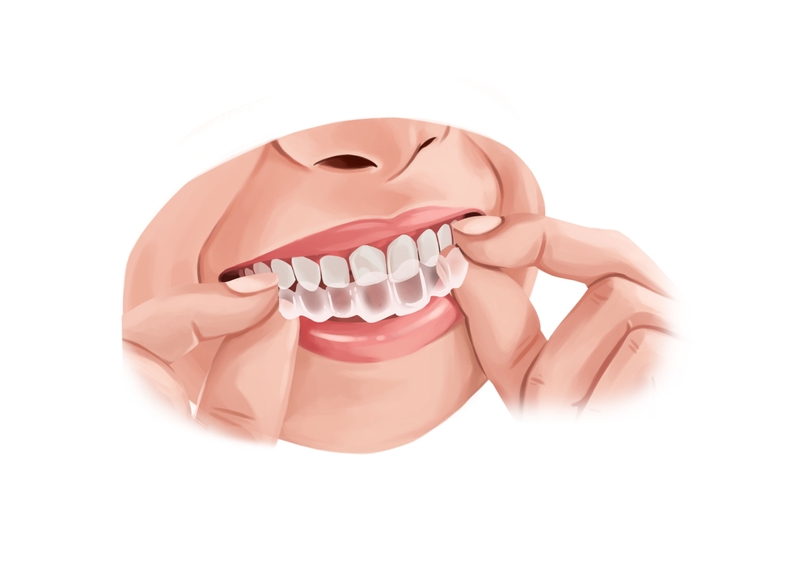- An underbite is a malocclusion in which the lower teeth protrude above the upper teeth. Genetic factors, childhood habits, trauma, tumors, and lesions can cause an underbite.
- An underbite affects appearance and oral health. It can promote the development of tooth decay, TMD and other serious health problems.
- Your doctor may treat your condition with orthodontic or surgical procedures. This depends on the severity of the underbite and your age.
How does underbite affect your health? Here's everything you need to know.
Underbite definition

Picture by Authority Dental under CC 2.0 license
It is the common term given to Class III malocclusion. The main characteristic of this condition is the protrusion of the lower teeth over their upper counterparts. Meaning that when you bite, your lower teeth are positioned in front of the upper ones instead of behind like they should.
This condition usually occurs when there’s a skeletal problem that results in a misalignment between the upper and lower jaws, such as protrusion of the lower jaw or the use of underdevelopment of the maxillary bone or upper jaw. However, in some cases, the issue is not related to skeletal problems but only teeth malposition.
Underbite does not look the same to everyone as the severity of this condition can range from mild to moderate and severe.
Although aesthetic issues may be the most obvious consequence of having underbite problems, there are more serious health problems associated with this condition.
Causes of underbite
The cause behind this malocclusion can vary from a person to another. Multiple factors contribute to the development of an underbite. Furthermore, in some cases, it could be attributed to a combination of different factors.
The most common reasons include conditions such as:
Genetics
The shape of your face, skeletal structure, and teeth are determined by your genetic. Overbite is a condition that is deeply tied to the genetic code. Moreover, it is usually inherited from your parents, and the odds of your offspring developing it are higher than the average person.
Childhood habits
Certain habits such as prolonged thumb sucking, bottle feeding for extended periods, constant use of pacifiers, and pushing on the teeth with the tongue can lead to jaw bone shape anomalies development. That is because children's bones grow at an accelerated rate and are easy to modify by external factors. It is essential to understand that these habits are only harmful when done for extensive periods.
Trauma
Same as with any other bone in your body, your jaw will try to heal if it breaks. However, in some cases, the broken portion of the jaw gets wrongly repositioned or moved through the healing process. It can cause the jaw to heal in an odd position or angle, resulting in an underbite.
Tumors and lesions
Certain tumoral growths and lesions can expand the jaw bone and change the alignment of the teeth. It is vital to attend consultation when growth has been spotted as it may require immediate attention. Although the size of the lesion does not always correlate with the danger it poses, a prompt response can make the treatment less invasive and easier to fix the underbite.
Genetic and uncontrolled habits during childhood are usually the chief causes of an underbite. However, as the development of this condition can be predicted and observed during the early stages of life, particular and timely measures can be promptly taken to prevent it from evolving and exacerbating.
How does underbite affect your health?
Underbite can have a negative impact on your overall health. Although appearance and aesthetics issues are the most obvious consequences of having this malocclusion, depending on the severity of the underbite, you could experience more dangerous consequences that may even affect your sleep quality.
Some of the underbite effects includes:
Temporomandibular Joint Disorder (TMD)
The temporomandibular joint (TMJ) is the joint that connects the jaw to the skull and allows it to perform different movements such as biting, opening, and closing the mouth with the aid of other facial muscles.
The mouth is designed to distribute the forces evenly when biting and eating to protect the teeth and joints. However, the misalignment produced by the underbite can cause an unbalance in this distribution. Therefore, harming the joint and creating a condition referred to as TMD.
This condition can cause joint pain, popping noises, and minor jaw deviations when opening or closing the mouth and even lock your jaw in an irregular and painful position.
Sleep apnea
A condition that causes you to repeatedly stop breathing for a few seconds when sleeping at night. It drastically decreases your sleeping quality and leads to fatigue.
Mouth breathing
This condition can dry your mouth and produce changes in its natural bacterial flora. Since saliva acts as a protector against gums disease and cavities, mouth breathing can decrease your oral health. Moreover, this can also cause bad breath as there is an excess of bacteria.
Emotional stress
Personal image issues can affect mental health. Ig can quickly turn into anxiety, depression, and low self-esteem.
How to fix underbite?

Picture by Authority Dental under CC 2.0 license
The treatment can range from traditional orthodontics to surgical procedures, and it will depend on the severity of underbite and the age of the patient. Children can wear interceptive orthodontics, which uses bone growth as a benefit to alter its shape and fix the malocclusion in a noninvasive way.
Braces
As an adult or teenager, braces can be used to fix mild cases of an underbite. They will pull the teeth back into a better position and help realign the jaw.
The dentist will perform a thorough evaluation of the case to design the best treatment plan that enables the teeth alignment and fix the malocclusion.
Invisalign
Clear aligners work the same way as braces or traditional orthodontics in the treatment of underbite. They are used in mild cases and fix it by strengthening the teeth to help realign the jaw.
The difference relays in the system used to move the teeth. Although Invisalign and other types of clear aligners can offer a more discrete solution than braces, they both will produce the same results.
Headgear (face mask)
Headgear is a specialized appliance that possesses two support points: one on top of the forehead and one on the chin. Both supports are connected by a vertical frame. It has bands that attach to the teeth and pull the whole upper jaw forward to align it with the lower jaw properly.
This treatment works better on younger patients whose bones are still developing.
The treatment time will vary depending on the severity of the underbite. However, it lasts approximately a year, and the face mask must be worn at least 16 hours a day.
Palate expander
This removable orthodontic appliance is placed on children’s palates and works by applying outward pressure to the teeth and bone. Palate expander possesses a mechanism that allows it to manually widen using a key. Doing so promotes palate expansion, making the bone grow until the upper teeth are no longer behind the lowers ones.
Surgery
Surgical procedures are required to treat severe underbite cases. Depending on the studied case, the surgeon can perform orthognathic jaw surgery to modify the lower jaw and place it in a correct position or a Le Fort III osteotomy where the upper jaw is separated and moved forward.
Cosmetic treatment
The dentist can opt to reshape the lower teeth and design veneers for the upper ones. However, it can only be done in mild cases, and although it will improve the aesthetic aspect, it will not completely fix the underbite as the molars may also be misaligned.
FAQ
What’s the difference between underbite and overbite?
They are both malocclusions. On an underbite, the lower teeth are positioned in front of the upper teeth, while on an overbite they are positioned behind them as they should.
However, the gap between lower and upper teeth is larger than it should, making the upper teeth protrude extensively and causing them to partially or cover the lower teeth completely. Underbite will give the face a square appearance, while overbite will make it look round.
Can you fix an underbite at home?
At what age do you fix an underbite?
It is recommended to do it during childhood, where it can be easily done using noninvasive methods. The treatment with interceptive orthodontics can be started as soon as 6-10 years old.
However, if the treatment requires surgery, it is expected to wait until the bones have fully developed. Thereby, as long as you can undergo a surgical procedure or orthodontic treatment, there is no top age to fix an underbite.
Can you prevent an underbite?
References
- Skeletal and dental effects of Class III orthopaedic treatment: a systematic review and meta-analysis
- Comparison of oropharyngeal airway dimensional changes in patients with skeletal Class II and Class III malocclusions after orthognathic surgery and functional appliance treatment: A systematic review
- Evolution of Class III treatment in orthodontics
- Treatment decision in adult patients with class III malocclusion: surgery versus orthodontics